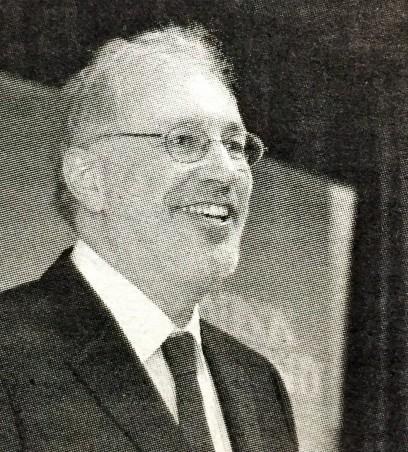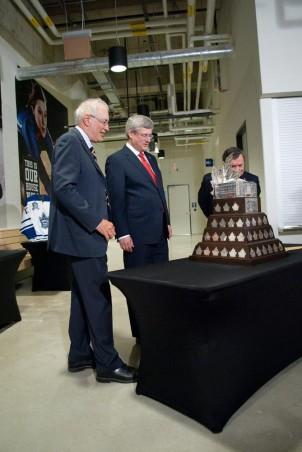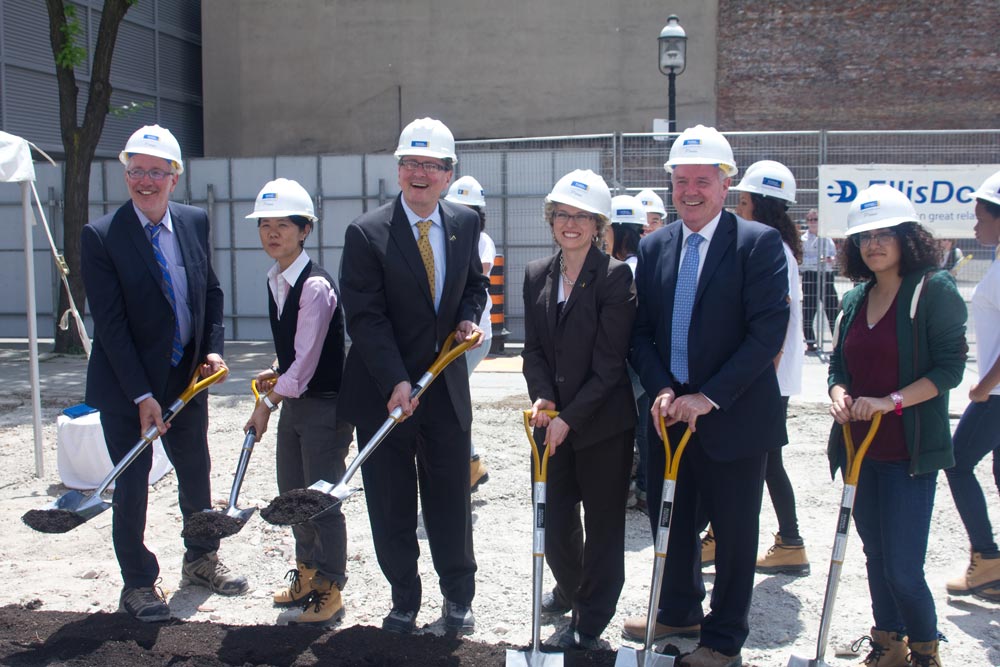

Ryerson President Sheldon Levy is packing up his office — this semester will be his last. JONAH BRUNET takes a deeper look at the man, the plan and the pursuit of a revitalized Ryerson"
Erin McGinn remembers her first meeting with Sheldon Levy after he became Ryerson’s president, walking together through Yonge-Dundas Square in the fall of 2005. Levy was trying to convince McGinn — a former colleague from his time working in government and institutional relations at the University of Toronto (U of T) — to come work with him.

The first photo of Sheldon Levy to appear in The Eyeopener, in the Feb. 2, 2005 issue of the paper. PHOTO ADRIAN MILANKOV
The square was an open construction site back then, unfinished top-floor interiors visible through skeletal steel-frame facades. Preoccupied with Ryerson’s dismal athletic facilities, Levy remarked, “Wouldn’t it be nice if someone put an ice rink up there?”
“‘What is he talking about?’” McGinn remembers thinking. “‘Who would ever put a skating rink on the third story of a building?’”
She accepted his offer and became assistant vice president of communications, government and community engagement.
Seven years later, Levy stood beaming on Ryerson’s third-floor ice rink as Stephen Harper dropped a ceremonial puck to mark the opening of the Mattamy Athletic Centre (MAC), a sprawling new athletic complex on the top two floors of historic Maple Leaf Gardens.
Levy couldn’t see the future, but he could help shape it, and did so multiple times to bring Ryerson closer and closer, building by building, to his vision. The expanded Ted Rogers School of Management, the Mattamy Athletic Centre, the renovated Ryerson Image Centre and, most recently, Yonge Street’s Student Learning Centre all stand in testament to his drive and ambition on behalf of his campus. Now, as he moves on to become Ontario’s deputy minister of training, colleges and universities, we at Ryerson are left to contemplate our university without him, and can’t help but wonder if the progress he championed will stop.
For those who know Levy — who worked alongside him over the past decade and will carry on without him come next semester — it isn’t an ardent city builder they will miss. It’s a man. It’s a personality, a warmth and a sense of humour. Levy’s many tangible accomplishments, expanding his campus both physically and in terms of student engagement, will no doubt come to define his legacy at Ryerson—but they’ve also been thoroughly covered, both in this and other Toronto publications. (Toronto Life ranked him 28 on a list of “The 50 Most Influential People in Toronto.”) Perhaps most remarkable about Levy is that, while accomplishing all that he did, he remained a pleasure to be around. He was always smiling. He seemed to be having fun.
“The thing about a leader is that you need to be all the things the business books tell you a leader should be—vision and hard work and so on,” says Charles Falzon, dean of radio and television arts. “But the real secret is that you have to be human first. That’s what strikes me about Sheldon.”
Sheldon Levy is the only son of parents from Poland and Russia — a truck driver and a homemaker. He grew up with two sisters in a small house near Dufferin and Eglinton. In his teens, he slacked off, skipped class and failed Grade 10 at Downsview Public School. He’s nothing if not relatable.

Sheldon Levy and Prime Minister Stephen Harper at the opening of the Mattamy Athletic Centre in August 13, 2012. PHOTO DASHA ZOLOTA
Levy’s path from high school burnout to Ryerson president was an unlikely one made possible by a series of mentors. The first was a high school teacher who recognized his talent for math, in which Levy went on to earn a master’s degree from York. The last was former Ontario premier Bill Davis who, when Levy was on the fence about becoming Ryerson’s president in 2005, urged him to stick with it.
Years later, Davis would phone Levy to inform him he’d won the 2014 Egerton Ryerson award for dedication to public education. Levy became the first person from Ryerson to receive Ryerson’s award.
Now, at 67, education is a common theme in Levy’s family. His wife and two daughters are all schoolteachers, making it no surprise when he asserts, repeatedly over the course of his tenure and at the heart of every decision he makes as president, that students come first.
Upon arriving at Ryerson, Levy was disappointed by the low amount of student engagement, with few electing to spend their free time on campus, before or after class. His predecessor, Claude Lajeunesse, was a nuclear physicist who’d worked hard to entrench Ryerson as a university in the academic sense, but had little of Levy’s charisma and hadn’t done much to enhance his students’ campus experience.
The Ryerson Levy saw in his first days as president was a university that struggled to express itself with the pride of historic schools such as Queen’s or U of T. It was an environment out of sync with what it meant to students, and the pride Levy knew existed. Adam Kahan, vice-president of university advancement, still remembers Levy’s first directive as president to improve his campus, bringing it physically closer to the way students felt about it: “Let’s plant flowers.”
Ten years after that first symbolic action, Levy says remedying the issue of student engagement on campus is his greatest achievement at Ryerson. “It’s grown from a commuter campus to a campus students want to spend their time on,” he says. Each new space he created for Ryerson all worked toward the common goal of students engaging with their university.
Levy’s decade of transformative city-building wasn’t only noticed by current students, but also did wonders for attracting prospective ones (a key indicator of success for any university). Ryerson currently receives approximately 10 applications for every available spot — higher than any other university in Ontario. And, compared to just over 4,000 when he began his tenure, last year Levy welcomed more than 7,000 first-year students to his campus. Growth for Levy was about students more than about buildings, and he was bringing his downtown campus more of both.
“I always wanted to leave when people said, ‘Why are you leaving?’” Levy says. “I never wanted to overstay my welcome.” But, in 2014, Ryerson’s board of governors quietly changed a long-standing university bylaw limiting any president to two five-year terms. The message, it seemed, was that Levy was welcome to Ryerson’s presidency for as long as he wanted.
Ryerson’s Student Learning Centre, opened earlier this year on the corner of Yonge and Gould streets, is an otherworldly eight-storey glass hulk that best illustrates Levy’s commitment to Ryerson students. “It wasn’t about monoliths to the administration or monoliths to research,” says Julia Hanigsberg, former vice-president of finance. “The most spectacular views were going to be given to students.
Although Levy gave the sleek, new and absurdly modern $112 million building to his students (while Ryerson executives remain in stodgy Jorgensen Hall, a grey-brown brick tower), Levy’s tenure hasn’t exactly been an act of charity. In 2013, the president of Ryerson made more than the president of the United States, taking home over $445,000.
But according to those who know Levy, whopping paycheques haven’t changed a thing about him. “He doesn’t take himself seriously,” Hanigsberg says. “He’s the least elitist person you’re ever going to meet. He doesn’t care if you’re a rich donor or a first-year student who just walked in and plunked yourself down in his office.”
"You’re going to have a really hard time getting anyone to say anything bad about Sheldon,”
Provost and vice-president academic Mohamed Lachemi, who will be taking over as interim president come December (an unenviable position due to the toughness of the act he must follow), first met Levy when he was a faculty member. He agrees the president’s humbleness was a defining characteristic. “You don’t feel that there’s a difference between him as a president and the rest of us,” Lachemi says.
From colleagues in administration even on down to the janitorial staff, Levy’s down-to-earth demeanour and active sense of humour had an impact on those he encountered. One janitor even wrote a song about Levy, and had it professionally recorded by a professor in the RTA School of Media.
“It’s difficult to leave,” says Levy when asked about his song, which was performed for him one morning in his office. “And it just makes it more difficult when people are thanking you.”
Considering his preoccupation with the needs and ideas of others — both students and fellow staff — it should come as no surprise that people generally like Levy. After all, his approach to presidency was emphatically about people. Hanigsberg speaks fondly of her first executive’s retreat at Levy’s cottage on Crowe Lake, explaining that the theme might as well have been, “What the hell do you want?” Levy was master of the brainstorming session and valued the ideas of others with a management style that encouraged participation from everyone. Hanigsberg calls it “spaghetti-at-the-wall leadership.”
“You’re going to have a really hard time getting anyone to say anything bad about Sheldon,” she says — a joke at the expense of my journalistic sense of balance. And, in the end, I never did.

Sheldon Levy, Councillor Kristyn Wong-Tam, Provost Alan Shepard, Julia Hanigsberg, Parliamentary Secretary, Minister of Training, Colleges and Universities Kevin Flynn and RSU VP Equity Marwa Hamad at the SLC groundbreaking ceremony on in May 30, 2012. PHOTO: LEE RICHARDSON
In his last month as president, it’s already become clear that Ryerson will miss Levy — from faculty to students to janitors. If not for all he’s done, the numerous grand achievements for which he’s been thoroughly praised (his farewell celebration is Nov. 25 at the MAC), we’ll miss him for who he was. Putting aside his accomplishments, which conjure images of business tycoons and million-dollar handshakes, Levy is best characterized by the little things — the small, human moments that will be remembered by colleagues long after his departure.
“It’s difficult to leave and it just makes it more difficult when people are thanking you."
For Lachemi, one such moment happened last winter, walking back from an off-campus event near University Avenue. Levy had suggested they walk in spite of the cold, which was increasingly getting to Lachemi, who had left his toque on campus. As soon as Levy noticed him shivering, he removed his own hat and insisted Lachemi take it. “I have more hair than him,” Lachemi quips. “But he forced me to accept it.”
Even after they made it back to campus, Levy refused to take his hat back. For Lachemi, now and more so come December, when Levy will leave Ryerson for Queen’s Park, it has become a fond memento. “I still have that hat,” he says, laughing. “I’m keeping it because it’s from him.”